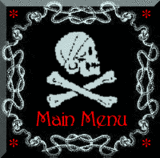

For more than two centuries a black flag with a white skull and crossbones (Jolly Roger) has been the symbol for pirates throught-out the western world. In popular fiction all pirates flew the jolly roger. However, this special flag was used only by British and British-American pirates from about 1700 to 1725. Other pirates attacked either under their own ruler's flag or under the flag of the official issuing their privateering commission. By flying a national flag, pirates made a symbolic statement (often false) that the attack was legal under that country's laws. Some nations sponsored piracy and lived off pirate booty, including Barbary states, the Knights of Malta, and 17th-century England. In law, corsairs operating from one of these havens had to fly its flag. This showed that the raiders recognized and paid taxes to the ruler's law courts.

The pirate flag, or Jolly Roger as it was also known was designed to strike fear into victims and encourage a hasty surrender. It probably traces its origins to the plain black flag that a ship would fly to warn another to surrender at once, or else it would be replaced by the red flag, or Jolie Rouge in French, meaning no quarter given (no mercy would be given to the crew). Many showed skulls and crossbones or skeletons, meant to warn of death if the victim did not surrender. Many of these symbols were probably borrowed from gravestones of the time. A few of the flags also contain an hour glass, meaning that time is running out for the victim to surrender peacefully. The pirates wanted to project fearlessness in the face of death, and some flags pictured the captain toasting, dancing with, or literally conquering the skeletal dead. Hearts to were often pierced to symbolize "no mercy".

While they were hunting, many pirates either flew no flag or used one that was meant to fool their intended victim. Normally their battle flag was raised only when they were close enough to attack. On one occasion the famous pirate Bartholomew Roberts was able to deceive the shipping off the island of Martinique by flying Dutch flags and making signals normally used by Dutch ships arriving from the Guinea coast of Africa with black slaves. This ruse enabled him to capture fourteen French sloops which came out to meet him with large sums of money on board for trading in slaves. Naval warships also used these tricks. In 1815 American ships thus trapped the 'Hamidou Reis' by flying the British flag. Some pirates, such as Edward Teach, better known as Blackbeard, kept a collection of flags on board and simply raised whatever was most convenient in any given situation.
Long John Silver
by John Masefield
We were schooner-rigged and rakish
with a long and lissome hull,
And we flew the pretty colors
of the crossbones and the skull;
We'd a big black jolly roger
flapping grimly at the fore,
And we sailed the spanish waters
in the happy days of yore.
We'd a long brass gun amidships
like a well-conducted ship,
We had each a brace of pistols
and a cutlass at the hip;
It's a point which tells against us
and a fact to be deplored,
But we chased the goodly merchantmen
and laid their ships aboard.
Then the dead men fouled the scuppers
and the wounded filled the chains,
and the paint-work all was splattered
with other peoples brains.
She was boarded, she was looted
she was scuttled till she sank,
And the pale survivors left us
by the medium of the plank.
Ah! the pig-tailed, quidding pirates
and the pretty pranks we played,
All have since been put a stop to
by the naughty Board of Trade;
The schooners and their merry
crews are laid away to rest,
A little south the sunset in
the Island of the blest.

Page best viewed with a 1024x768 screen resolution.
Copyright © 2000-2005 KAL/BrethrenCoast, All Rights Reserved.















